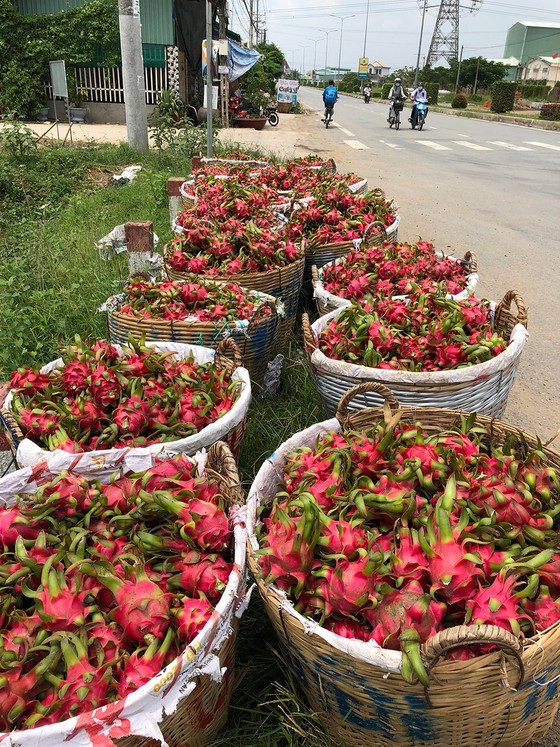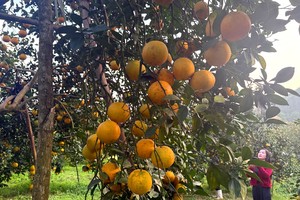
In Mekong Delta province of Tien Giang, in 2017, there were around 6,000 hectares of dragon fruit plants, concentrating in Cho Gao District. Since 2018 to now, although the price of dragon fruits has continuously marched down and investment cost is extremely high which is around VND250-VND350 million per hectare, many farming households still abandoned rice paddy fields, pineapple fields and fish ponds to switch to cultivate dragon fruit plants. Noticeably, the additional area of dragon fruit plants of nearly 2,500 hectares gathered most in Tan Phuoc District, a remote district in the Plain of Reeds, an inland wetland in the Mekong Delta, where farmers mainly grow rice and pineapple plants.
In Long An Province, dragon fruit was mainly grown at Chau Thanh District with an area of more than 2,000 hectares. In the past two years, farmers have expanded growing area to more than 11,777 hectares, scattering in other districts as well instead of in Chau Thanh District alone. For instance, Tan Tru District, which used to specialize in rice cultivation and saltwater shrimp farming, has now had nearly 1,000 hectares of dragon fruit plants while other floodplain districts also have more than 1,000 hectares of dragon fruit. Tan An City also has 750 hectares of dragon fruit.
According to explanation of Mr. Tu Phuong, a farmers in Duc Tan Commune in Tan Tru District, shrimp farming and rice cultivation are chancy whereas growing dragon fruit is more promising as farmers are able to be more certain about profit and loss. He said that he had raised white-leg shrimps in an area of 5,000 square meters for three years. He suffered losses in two years and had profit in only one year but the profit was not high. Growing rice is just like ‘exchanging old money for new money’ but the “new money” is less than investment capital. Growing dragon fruit, although farmers have only harvested for a few crops and the price was low, in the long term, it still gives higher profits than shrimp farming and rice cultivation.
Mr. Le Van Tai, a farmer in Thanh My Commune in Tan Phuoc District of Tien Giang Province, also said that growing rice and pineapple is not as lucrative as growing dragon fruit. A hectare of rice requires an investment of VND25 million-VND30 million, if the price of rice is high, farmers ear a profit of VND5 million-VND10 million; but if the price is low, farmers will break even or suffer loss. If farmers grow rice for three crops each year, investment cost and risk will be higher. Meanwhile, although the initial cost to grow dragon fruit is high, farmers only have to grow the plant once then harvest for many years and production of dragon fruit is extremely high. If the plants are 5-7 years old upwards and there are three crops annually, the production might reach 50-60 tons per hectares. The price of dragon fruits just needs to be at VND5,000 per kilogram, the profit is much higher than that from growing rice.
Possibly because of that, Mr. Bay Cung, a farmer in Tan Tay Commune in Thanh Hoa District in Long An Province, shifted to grow dragon fruit on his 1.7 hectares of rice growing land with an investment cost of above VND500 million, hoping that it will change his life. Many other farmers in districts in the Plain of Reeds also did that. They were willing to abandon rice in order to grow dragon fruit. Since the beginning of last year, farmers in this region have switched to grow dragon fruit on nearly 2,000 hectares of rice growing land.
According to Mr, Cao Van Hoa, deputy director of the Department of Agriculture and Rural Development of Tien Gang Province, dragon fruit has helped life of several farmers to be better than rice or other crops. As dragon fruit has been considered as one of key fruits, the province attaches much importance to growing area project and infrastructure in order to support farmers. Application of advanced science and technology is also supported and encouraged. The province aims to reorganize production in the direction of connecting value chains, promoting advertising, promoting trade and diversifying consumption market to help farmers to live on dragon fruit well.
However, Mr. Le Minh Duc, director of the Department of Industry and Trade of Long An Province, said that 80 percent of Vietnamese dragon fruits were exported to China. Every time consumption at this market is stagnant, dragon fruits are unsaleable. Therefore, farmers should balance profit and possible risk and take initiative in consumption.
























